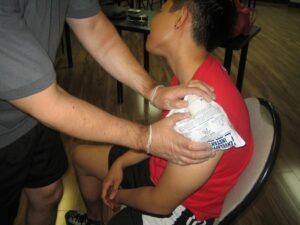The rotator cuff is a group of four muscles and tendons that are responsible for stabilizing the shoulder as well as helping with movement. It is used when lifting your arm over the head or pulling an object. A rotator cuff injury includes tears, tendinitis, strains and bursitis.
Causes of rotator cuff injury
The rotator cuff injuries can be mild or severe and typically categorized in three types.
- Tendinitis is caused by overuse resulting to inflammation.
- Bursitis is caused by inflammation of the bursa which is the fluid-filled sacs in the rotator cuff that facilitates motion. This occurs due to degenerative damage or injury.
- Strains or tears are caused by acute injuries or overuse. Take note that the tendons connecting the muscles to the bones can overstretch or tear partially or completely. Tears or strains can also develop after a vehicular accident, falls or abrupt injuries resulting to immediate and intense pain.
Who are at risk?
A rotator cuff injury might be acute or degenerative. For the acute cases, they are caused by earlier injuries. It can be caused by lifting heavy objects or falling. This is usually experienced by young individuals. As for the degenerative cases, they are due to long-term misuse. Individuals who are at risk for these injuries include athletes, tasks that involve repetitive lifting and individuals above 40 years old.
Symptoms of rotator cuff injury
Take note that not all injuries can cause pain. Since some are caused by progressive conditions, the rotator cuff can be impaired for months or even years before the symptoms will manifest.

The common symptoms include:
- Limited range of shoulder motion
- Tenderness or pain when reaching overhead
- Difficulty sleeping on the affected shoulder
- Pain in the shoulder especially during night time
- Difficulty reaching behind the back
- Progressive weakness of the shoulder
If an individual experiences these symptoms for more than 1 week or the functionality of the arm is lost, it is best to consult your doctor.
Treatment for rotator cuff injury
The treatments for this injury range from resting the affected arm or even surgery. For the non-surgical treatments, these can help improve the symptoms. These first aid measures can be performed at home:
- Apply warm or cold packs on the affected shoulder to minimize the swelling
- Instruct individual to perform exercise to restore strength and range of motion
- Allow the individual to rest the affected arm or use a sling
- Provide over-the-counter medications such as naproxen or ibuprofen
Individuals who engage in sports or activities that involve the repetitive use of the shoulder must take regular breaks so that it will minimize the load or strain on the shoulder. Exercises that help strengthen the shoulder can be performed. With the help of home care, injuries can be easily prevented. On the other hand, for severe cases, the shoulder strength might not improve unless it is surgically corrected.
